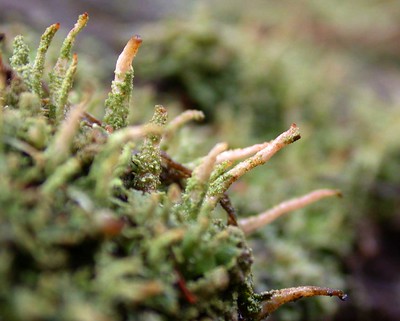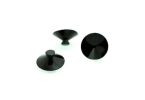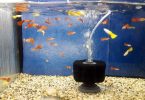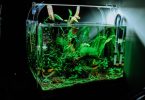Table of Contents
In this article we will be discussing about all we will need to know about floating plants for an aquarium –
benefits of these plants, factors to consider when adding these plants and the best floating plants to add. In the world of aquarium fishkeeping, there are many factors that directly contributes to the success of an aquarist in keeping fishes alive and healthy.
Sometimes, a lot of people focus only on the tank water conditions, believing it to be the singular most important aspect of aquarium fishkeeping. This, however, is incomplete, if somewhat wrong, assessment.
Other factors like the compatibility of a fish with the other fishes in the tank matters. Especially in deciding whether to keep a species only tank or a community tank.
The substrates in the tank are also very important as they serve various purposes such as providing the fish with cover, (as in the case of nano fishes such as chili rasboras and its likes especially from predators in a community tank) something to cling on in search for an optimal feeding position (as in the case of aquatic invertebrates such as bamboo shrimps) and quite simply as a consideration to prevent the fish from getting hurt (as in the case of bumblebee catfish who has skin instead of scales on its body).
Another very important factor in aquarium fishkeeping is the type of aquatic plant in the tank. These plants serves a range of purposes directly significant in creating a clean and healthy, as well as, safe environment for fishes in an aquarium tank.
They also have a lot of other functions which are really beneficial to, not only the fishes but also, the fishkeepers and which would be fully covered in the following parts of this article. Moving on, there is a special category of plants best suited for aquarium fishes and this category of plants is known as floating aquantic plants.
A few characteristics of aquatic plants includes:
- Thin or no cuticles as they do not particularly need them.
- Stomata on each side of their leaves which are kept open as they do not need to retain water.
- Less rigid structure due to support form water pressure.
- Flat leaves suitable for floating.
- Air sacs which also enables them float.
- Light and feathery roots as they are not really needed to hold up the plants.
- Specialized roots that take in oxygen
- Small roots which enables water spread directly into the leaves.
Aquatic plants adaptation is obvious by the structure, which has leaves that are wavy and sissecte, pollination mechanism and different pattern of growth that are specialized.
Given by its adaptation, such plants include the following:
- The naiad, this is a plant that is fully submerged, and are taken to be real aquatic plants. There are lots of them and they are equally called the hydrophytes.
- Plants that float: Plants like this have their roots in water that floats, just like the water lily, and then the duckweed that is not rooted at all.
- Plants of the swam: The reed mace is an example of this, however it is submerged, but not fully submerged. In the following parts of this article, we would be looking at macrophytes and more specifically floating plants, their advantage as well as the best ones for your fish tanks.
Macrophytes
This species are main producers for many organisms in the food web. Macrophytes have important effect on the chemistry of the soil, and the light level as they control the flow of water. Species with floating leaves have roots that are attached to the water, especially the depth of the water or an aquarium tank.
Aquarium plants float and create a completely new feel to an aquarium tank. Their presence in your tank would complete the required scene a fishkeeper would need to destress and relax; as they are very beautiful and calming to observe, and would as well provide a wide range of advantages to the fishes in your tank.
Merits of Adding Floating Plants to your Aquarium.
- Aids recreation of natural habitat cover: The amount of light filtering into your aquarium is a very important factor to successfully keeping fishes as pets.
While some fish species thrive in adequately lit waters, some are extremely shy and are active either at night or in a very shady tank. Floating plants provide the much needed cover to fishes that are used to shady waters as they float along the surface and directly dictate the amount of light that gets into the waters.
This cover helps recreate the feel of the fish’s natural habitat and ensures they feel very comfortable physically as well as emotionally as it hugely reduces their stress levels. It is however very important to take the time needed to consider the exact plant perfect for the amount of light required by the fish species in your tank.
- Diet supplement for fishes:
Fishes are curious omnivores who enjoy a varied diet. As they are used to getting supplementary nutrition, it would not be rare to find your fish taking bites out of the vegetation in their tank. So, the right floating plant serves as a means of further getting vitamins and much needed nutrients for the fishes in your aquarium.
Performing its natural functions to maintain water conditions: Plants generally help out the ecosystem in a host of beneficial ways. This is equally true of floating aquarium plants. They help out the fishes and the fish keeper in such a way that makes fishkeeping easy, comfortable, stress-free and above all successful. The plants help in filtering the water which in effect limits the amount of waste present in the aquarium water. This helps keep the water clean for the optimal health of this fishes.Plants makes it easier for fish keepers to manage the nitrate levels of their tank water.
They do this by absorbing nitrates from the water column and using them as fertilizer by performing the normal process of photosynthesis. They also help in oxygenating the water in a way that cannot be artificially recreated. Plants are also an effective supplement to the filtering system used in filtering the tank water.
So, you need not be wary of making use of them up to their fullest potential. Protection from predators: Fishes that are small and generally preys to bigger fishes need the added level of security that certain floating aquarium plants provide. Their continued safety and comfort helps in reducing their stress levels, which is of paramount help to their general health status. Low maintenance: Many people worry about the added requirements in taking care of their plants as well as their fishes.
However, lots of aquarium plants are hardy and hard to kill, even if one tried. They are also really easy to care for which makes it very easy to keep them and as well be able to pay full attention to the fishes. Floating aquarium plants, in particular, are spectacularly easy to maintain as all they mostly require is trimming to regulate plant growth. Factors to consider in getting floating aquarium plants.
Floating plants have a plethora of merits as can be seen from the previous sections. To choose the best plant species for your tank however, you have to consider some or all of the following as the case may be.
- The type of fish species in tank: Like we know, pet fishes have very particular conditions that needs to be met to ensure there is no spike in their stress levels. In respect to this, one has to consider the type of fishes in their tank and the plants that are most suited to their natural habitat before procuring floating aquarium plants for them.
For example, fishes like guppies, mollies, platys and its types are typically ready breeders; so, floating plants that have their roots trailing down into the water is liable to provide the best shelter for their fry so as to keep them from being snacked on. In the same vein, shy fishes like the bumblebee catfish would feel safer and a lot less stressed if they are able to hide among the roots of floating plants.
On the other hand, in a tank with bettas or gouramis who are labyrinth breathers, you have to be careful to use floating plants that affords the fishes the surface they need to get to, to enable proper breathing.
- Size of the tank:
The main requirement in maintaining floating plants is prompt and adequate trimming that regulates growth of aquarium plants as a lot of them are known for their speedy growth. So, in getting one for your tank, you should bear in mind that having rapidly growing floating plants can overcrowd a small tank and the fishes in it which is very detrimental to the stress levels of fishes. So, you have to endeavor to get plants whose growth is commensurate to the size of the tank you have. Required lighting for the fish species in your tank:
We have previously mentioned, as a part of the merits of floating plants to your aquarium the vital role it plays in filtering the light that enters your tank. So, we can see that its importance cannot be overemphasized. Not just in relation to the fishes but in relation to the plants themselves. There are fishes that prefer dim lighting and when keeping plants at the bottom of the tank; that cannot thrive in such conditions, you need to be mindful that the floating plant you get are those that thin easily and do not cut of available surface light to the flora at the base of the tank.
Growth level of plant in tank: We have also previously mentioned a benefit of floating plant to aquariums to be their growth level. This means that they are quick to cover up the surface of tank water as well as clog up the tank water with their trailing roots. So, one should bear this in mind and only buy the barest minimum required to create the look you’re going for as well as be prepared to trim the plants regularly.
Care for floating plant in tank:
Yes, floating plants are plenty low maintenance. One, however, needs to maintain high humidity level above the waterline. This helps in preventing the leaves of certain plants, such as water lettuces, from dehydrating and turning brown. To achieve this, a tank with a hood is highly recommended.
You also have to keep in mind that floating plants are fragile. So, they are best suited for water bodies with slow to moderate movements to prevent them being broken and their leaves bruised by really strong water currents.
Best Floating Plant for Your Aquarium.
The following are some of the most widely acclaimed best and low maintenance floating plants for your aquarium
-
Hornworts
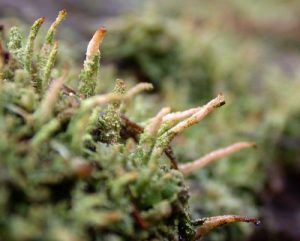
Hornwort is an extremely popular floating plant. It is very disease resistant and easy to grow and it can be planted into the substrates or left free floating on the surface of the water. It prefers low lighting as bright lighting makes its branches too long and string looking. It should be trimmed regularly to forestall clogging of filter system.
2. Java Moss
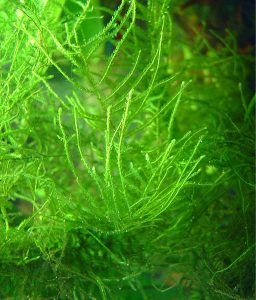
Java Moss is not only pretty but also remarkably easy to grow. It can be grown on a rock or piece of wood by the simple act of fixing the plant in the wood or rock. It can also be grown on the surface by leaving it to roam around on it. Java Moss is popular by breeders in spawning tanks. This is because it provides the required mesh needed to hide vulnerable fry from predators who see them as preys.
3. Duckweed
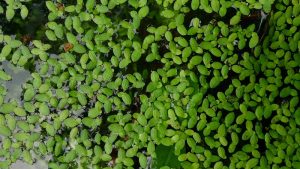
Duckweed is very popular as a surface plant for aquariums because it grows at an alarmingly fast rate. It grows in slow moving water bodies with a carpet of light green tiny leaves. It does best in moderate light conditions.
4. Amazon Frogbit
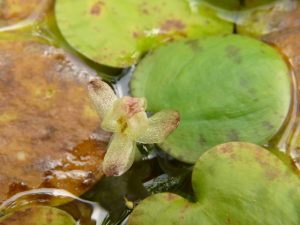
Like duckweed, the amazon frogbit grows easily and fast. It requires no other maintenance than trimming. One should make sure that the plant is not water logged to keep it from rotting. It leaves are circular in shape and bright green in color. It is very hardy and can be enjoyable for snails.
5. Anacharis

Anacharis is a plant that survives in a wide range of conditions. It can be grown in the substrate of tanks or can be left to float freely in the water column. A fun fact is that the plant rises and falls in response to the time of day and temperature of tank. It comes out in warm temperatures to soak up the sun at the surface and falls back when the weather is cool or at night. It is dark green in color.
6. Water Sprite
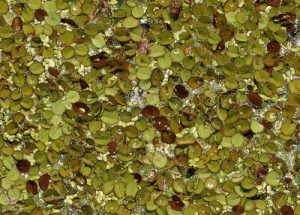
Water Sprite is commonly found in pet stores. They can be planted in substrates or allowed to roam freely too and only require a little trimming to regulate it’s growth. They are delicate and most commonly known as Water Fern, Indian Fern and Indian Water Fern. It is very helpful in providing shelter for small or shy fishes.
7. Water Spangles
Water Spangles have large flat leaves that provides protection and feeding area for aquatic animals. They are hardy and easy to grow. They also require moderate lighting and does not like fast moving water surface.
8. Water Primrose
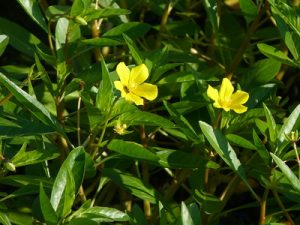
This plant is different from the above mentioned free floating plants because, while most of the above are green plants, the Water Primrose has dark red and brown colors. So, it adds a variation to the beauty of your tank and is as well easy to grow.
9. Floating Bladderwort
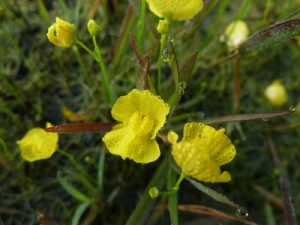
Floating Bladderwort is quite a unique aquarium plant. Not only is it easy to grow, it produces yellow flowers which adds to the aesthetics of your tank. It is also a carnivorous plant but it generally feeds on microorganisms and zooplanktons; so, there i no danger to your fishes. To maintain it, you need only take out new plantlets to keep tank from being overwhelmed by it.
10. Water Lettuce

Water Lettuces are very beautiful and are great in creating an attractive aquascape, especially in large tanks. It also grows very fast and to keep it very healthy, it is required that you remove the dead and yellowing leaves and excess plants.
11. Water Sprite
Water Sprite is commonly found in pet stores. They can be planted in substrates or allowed to roam freely too and only require a little trimming to regulate its growth. They are delicate and most commonly known as Water Fern, Indian Fern and Indian Water Fern. It is very helpful in providing shelter for small or shy fishes.
Conclusion
The floating plants in this article are great for beginner fish keepers as well as experienced ones. But, like every other aspect of pet fishkeeping, adequate research should be made before the addition of any organism; plant or animal, to your tank.
Regardless of what scene you want from aquascaping your tank, there are plants that would always readily fit your desires. Floating aquarium plants helps mimic the wild natural look of the actual natural habitat of the fishes and what is more, the amazing finished look and feel of serenity it gives your tank is definitely worth the little maintenance it does require.

